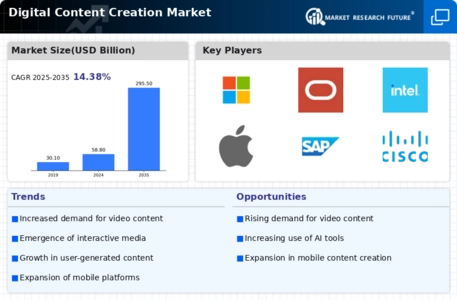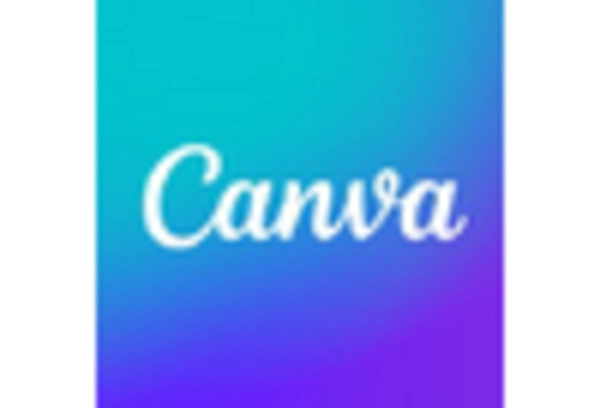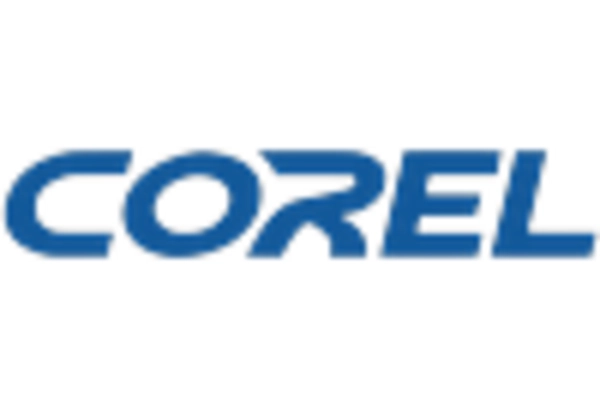Advancements in Technology
Technological advancements play a pivotal role in shaping the Digital Content Creation Market. The emergence of sophisticated software and hardware tools has democratized content creation, enabling individuals and businesses to produce high-quality content with relative ease. For instance, the adoption of augmented reality (AR) and virtual reality (VR) technologies is transforming how content is created and consumed. As of 2025, the market for AR and VR content is projected to reach substantial figures, indicating a growing appetite for immersive experiences. Additionally, the proliferation of mobile devices equipped with advanced cameras and editing software has empowered creators to produce content on-the-go. This technological evolution not only enhances the quality of content but also broadens the scope of creative possibilities, thereby driving growth in the Digital Content Creation Market.
Rise of Social Media Platforms
The proliferation of social media platforms has catalyzed the Digital Content Creation Market. As of 2025, approximately 4.5 billion individuals engage with social media, creating a robust demand for diverse content formats. This trend compels brands and creators to produce engaging videos, graphics, and written content tailored for various platforms. The need for high-quality, shareable content drives innovation and investment in content creation tools and services. Furthermore, the rise of influencer marketing necessitates a continuous flow of fresh content, thereby expanding opportunities within the Digital Content Creation Market. The integration of analytics tools allows creators to refine their strategies, enhancing audience engagement and retention. Consequently, the symbiotic relationship between social media and content creation is likely to persist, fostering growth in the industry.
Growing Demand for Video Content
The increasing demand for video content is a significant driver of the Digital Content Creation Market. As of 2025, video is projected to account for over 80 percent of all internet traffic, underscoring its dominance in content consumption. This trend compels businesses and creators to prioritize video production, leading to a surge in demand for video editing tools and platforms. The rise of live streaming and short-form video content, particularly on platforms like TikTok and Instagram, further amplifies this demand. Consequently, content creators are investing in skills and technologies that enhance their video production capabilities. This shift not only influences content strategies but also fosters innovation within the Digital Content Creation Market, as new formats and styles emerge to capture audience attention.
Emergence of E-Learning Platforms
The rise of e-learning platforms has significantly influenced the Digital Content Creation Market. With the increasing demand for online education and training, content creators are tasked with developing high-quality educational materials, including videos, interactive modules, and assessments. As of 2025, the e-learning market is projected to reach substantial valuations, indicating a robust appetite for digital learning solutions. This trend necessitates the creation of engaging and informative content that caters to diverse learning styles. Furthermore, the integration of gamification and interactive elements into educational content enhances learner engagement and retention. As educational institutions and businesses invest in e-learning solutions, the demand for innovative content creation tools and services is likely to grow, thereby propelling the Digital Content Creation Market forward.
Increased Focus on Personalization
Personalization has emerged as a critical driver within the Digital Content Creation Market. As consumers increasingly seek tailored experiences, content creators are compelled to develop personalized content strategies. Data analytics and artificial intelligence tools enable creators to understand audience preferences and behaviors, facilitating the creation of content that resonates on an individual level. This trend is particularly evident in email marketing, social media campaigns, and targeted advertising, where personalized content yields higher engagement rates. As of 2025, businesses that prioritize personalization are likely to see improved customer loyalty and conversion rates. This emphasis on tailored content not only enhances user experience but also drives competition within the Digital Content Creation Market, as creators strive to differentiate themselves through unique and relevant offerings.

















Leave a Comment